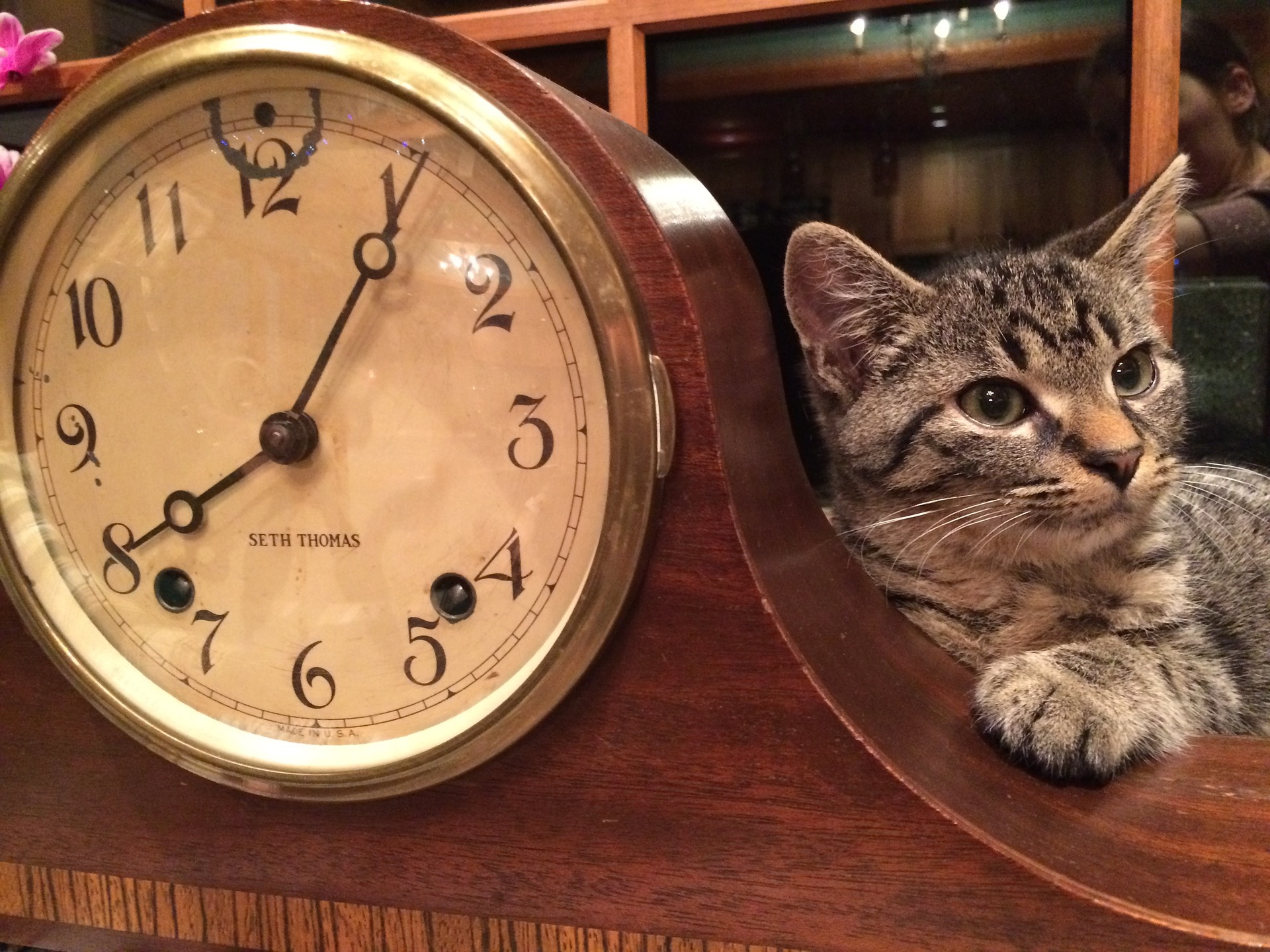Are you tired (literally) of your cat jumping on you at 4:00am?
Do the animals start begging for dinner over an hour before mealtime?
Are you afraid that if you let your pet out before you leave for work they won’t come back in time for you to leave the house?
Do you have a hard time getting your cat in before dark?
Ready to learn one easy way to deal with these?
Teach your pet time!
 Really! Why would you want your animals to know time?
Really! Why would you want your animals to know time?
For one, it’ll make your life easier, case closed.
But also, it can help particularly anxious animals, and routine-driven animals.
I know, you may think I’m crazy to suggest that animals can know time, but stay with me. I’m not expecting them to look at a clock and paw out that it’s 4:15pm, but they are capable of understanding what an hour is, or overnight is, and I have many success stories to back this up.
Once you’ve introduced your animals to time, you’ll see how invaluable it is for keeping order and harmony in your life, and in the home.
The concept was suggested to me by a previous teacher so I wanted to try it for myself. My first experience was with cat-sitting my daughter’s two cats, Chloe and Lily. Chloe was a true explorer and hunter that cost me hours of worry. (In retrospect I could have used a GPS tracker or Catio, but then I wouldn’t have gained this important insight.) Within days I trained Chloe to check in with me every 20 minutes!
What else have I used time teaching for? I’ve stopped my cat Roxy from waking me every morning between 3:00 and 4:00am, I’ve helped a client stop their dog and cat from begging for dinner until it really is dinner time, I’ve helped another client calm a very anxious dog (separation issues) now that he knows how long it will be before momma is back home, and numerous clients use it to help keep their wandering animals close to home and back inside before dark!
How to teach time to your animals – step by step.
Begin by telling them often how long something is. This is key: in order for them to start to grasp the concept of time they need to see how it applies in everyday life. For example: dinner is in one hour; I’m going to watch TV for 30 minutes; let’s take a 20-minute walk; I’m going to bed at 10:00pm; George will be here in about 2 hours; I will be gone for 2 nights; I’m taking a 15-minute bath; my alarm will go off at 7:00am; our favorite TV show is on at 8:00pm…I think you get the idea here – just start by telling them how long everything is as well as if something happens at a specific time.
Next – start asking them to do something for a specified amount of time or by a certain time. For example, with Chloe I said “Be back in 20 minutes.” When they come back be sure to correct them and let them know the actual time spent. “Chloe, that was 30 minutes, I need you back sooner, in 20 minutes.” Continue to correct: “Chloe, that’s 15 minutes, you can have 5 more minutes before checking in.” Constantly correct them so they know where they stand – too long or too short an amount of time. They will become consistent. It may take a day or a week or 3 weeks, but it will happen if you are consistent with your end of the training. 
For Roxy and the bed, I combined time with saying what I want: “Roxy, stay asleep or in the living room until 7:00am.” (Never say “don’t wake me up” – that is covered here.) If Roxy jumped on me before 7:00am I would let her know, “It’s only 5:00am; stay asleep or in the living room for 2 more hours.” Again, it wasn’t immediate but she learned pretty quickly to let me be until I told her it was okay. I don’t always get up at the same time, so I would say “until the alarm goes off,” which works just as well.
Finally – repeat as needed. Once you establish the concept of time, it’s just a matter of correcting their response when asked to complete a timed assignment. Correct and praise is the pattern from here on out!
How does this help an anxious dog? By knowing Momma is coming back in 2 hours and not an undetermined amount of time or maybe never, maybe being abandoned – again! If they know it’s a short period, it’s much more manageable. I encourage you to be honest with your anxious animals when it comes to the length of time you’ll be gone. If they have a good idea what 2 hours is and that is what you’ve told them, at 3, 4 or 5 hours they will begin to wind up and be overly anxious every time you go out again. I know sometimes things get delayed, so if you get home late, explain why you were home late. Even apologize and explain – they do understand more than you may realize! (Read more on that here.)
To put an end to the early dinner begging – same principle. Let them know how long before dinner (“Still 90 minutes before dinner”), and in fact even if they aren’t begging for dinner, let them know if it’s coming up in 30 minutes at 5:00pm, just to help reiterate the time concept.
 Pets come into our homes with no concept of time as humans use it, so just like children we need to introduce them to it, and they learn. Try it out – it really can shift a household when you can tell them that you’ll be done at your desk in 60 minutes and they go lay down instead of staring and whining at you for 30 minutes until you give in!
Pets come into our homes with no concept of time as humans use it, so just like children we need to introduce them to it, and they learn. Try it out – it really can shift a household when you can tell them that you’ll be done at your desk in 60 minutes and they go lay down instead of staring and whining at you for 30 minutes until you give in!


